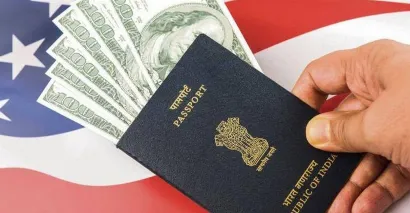Key Highlights
The Department of Homeland Security is putting together a landmark regulatory modification that might alter the way thousands of skilled foreign workers access job-based green cards. The regulation proposed will update and define the eligibility rules that require individuals to have permanent residency in the case of employment eligibility.​
This comes after the years of policy modification in the Biden administration that made skilled workers' immigration to the United States initially easier. Nonetheless, the next regulation is an indicator of a possible increased strictness in the standards that may impact further applicants and recruitment by employers.​
Key Changes in the Proposed Rule
The DHS rule will revise rules that cover extraordinary ability types and excellent professors and researchers. The abstract prepared by the agency indicates that the rule will modernize existing outdated provisions of the authorities of extraordinary ability and outstanding professors and researchers, and make clear the evidentiary requirements of first preference classifications, second preference national interest waiver classifications, and physicians of national and international reputation.​
The government will redefine the eligibility and documentation standards that foreign professionals will need to have in order to qualify for permanent residency. These updates are supposed to overcome discrepancies in the interpretation of evidence and enhance the process of review of petitions in the first and second preference categories of employment.​
Also Read: U.S. Launches Jobs and Internships Platform for Indians
Background of Biden Administration Immigration Policies
The program is the next step in the series of actions by the Biden administration to make the process of inviting skilled foreign employees easier. On January 21, 2022, the administration provided new guidance that urges employers and high-skilled workers to better utilize the O-1A visa category and national interest waiver categories.​
The strategy was to attract talent in science, technology, and research throughout the world. It was also in line with the policy of administration to make the country stronger in innovation and competitiveness through the facilitation of visas to those who can serve the national interests.​
The Biden administration showed the most activity in terms of immigration, making 605 immigration-related executive actions as of December 2024. These measures involved an attempt to ease the way to the employment of US college graduates and retain families.​
Impact on O-1A Visas and National Interest Waivers
Since the new policy in 2022, the number of applications to obtain O-1A visas and national interest waivers has grown considerably. USCIS statistics indicate that O-1A cases have increased since 7,710 cases were allowed in fiscal year 2021 to 10,010 cases approved in the fiscal year 2023, with the approval rate remaining at over 90%.​
|
Fiscal Year |
O-1A Applications |
Approval Rate |
|
FY 2021 |
7,710 |
91% |
|
FY 2022 |
9,970 |
94% |
|
FY 2023 |
10,010 |
92% |
National Interest Waiver Application Surge
Demands for national interest waivers also soared. An overview of NIW applications revealed in a study by the National Foundation of American Policy indicates that NIW application receipts increased by 51 percent between FY 2021 and FY 2022 -14,610 to 21,990. This has been on the rise in FY 2023, where applications increased 81 percent to 39,810.​
Nonetheless, the rates of approval of NIW petitions have experienced a drop during the same time. Between FY 2022 and FY 2023, the national interest waiver approval rate fell by 90 percent to 80 percent.​
Read More: US Visa Rejection Reasons: Avoid These Mistakes
Expected Rule Components and Changes
The next regulation is called the Petition to Immigrant Worker Reforms, which is the largest regulatory update in decades regarding employment-based petitions. The rule is trying to update the provisions that are old-fashioned, codify old policies, and enhance the program integrity.​
Some of the key changes expected involve codifying the policy guidance by which the USCIS has been operating through internal policy memos to address matters such as successorship in interest and the ability to pay criteria. These principles will be shifted to formal regulation under the new rule and accorded more weight and consistency.​
The new rule will probably provide more specifications of the evidentiary needs of particular employer-based types of green cards, such as EB-1 Extraordinary Ability applicants, EB-1 Outstanding professors and researchers applicants, EB-2 National Interest Waiver applicants, and physicians of national or international repute.​
Potential Industry Impact
The immigration lawyers feel that transparency in evidentiary standards can contribute to decreased inconsistent decision-making, but can also increase the standard of proving extraordinary ability or national significance. Kevin Miner of Fragomen reported that they have, of late, started to receive more Requests for Evidence associated with a national interest waiver, showing that USCIS might be becoming more stringent in its strategy.​
The rule may redefine the path of high-skilled immigrants in the employment-based green card system, affecting the recruitment methods of the US employers and the career ambitions of the international professionals interested in settling in the nation. The clarification can be used to the advantage of well-prepared applicants, but it complicates the position of a person who does not possess strong documentation.​
|
Current Category |
Expected Impact |
|
EB-1 Extraordinary Ability |
Stricter evidence standards |
|
EB-1 Outstanding Professors |
Clearer documentation requirements |
|
EB-2 National Interest Waiver |
Enhanced scrutiny of national importance claims |
Implementation Timeline and Next Steps
The rule is at its draft stage and is planned to be published in January 2026. It will be published, after which it will be open to the suggestions of the people before any subsequent implementation. The employers, universities, and immigrant advocacy agencies are the stakeholders whose attention is expected to be drawn to the proposal since its release.​ The DHS has yet to publish the text of the proposed rule as well as the elaborate requirements of the rule. The changes should, however, be expected to impact EB-1, EB-2, and EB-3 categories, which are the major avenues through which foreign nationals can get permanent residence, depending on their employment.
Also Read: US Issues Over 1 Million Non-Immigrant Visas to Indians
Conclusion
The new US employment-based green card rule is a major change in the immigration policy that may impact thousands of foreign professionals with high skills in permanent residency. Although the rule is designed to update the obsolete provisions of the process and offer clarity to the process of application, it will also introduce new difficulties to applicants and employers who have to find their way through the complicated system of immigration policies. The fact that it will be published in January 2026 will give the stakeholders time to prepare for the possible changes that may transform years of employment-based immigration.​​ For official information about employment-based green card regulations and updates, visit the U.S. Department of Homeland Security's official website, where comprehensive immigration policy details and regulatory changes are published. To know more about the U.S. skilled immigration, visit TerraTern now!








